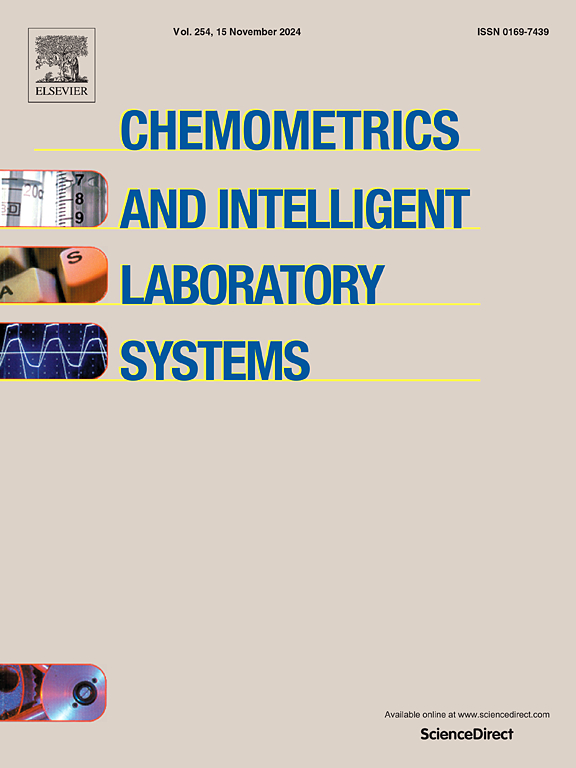Optimizing dehydrated soups with advanced algorithms: A novel application of D-Optimal mixture design and NSGA-II for healthier formulations
IF 3.8
2区 化学
Q2 AUTOMATION & CONTROL SYSTEMS
Chemometrics and Intelligent Laboratory Systems
Pub Date : 2025-05-24
DOI:10.1016/j.chemolab.2025.105443
引用次数: 0
Abstract
This study explores the optimization of dehydrated soup formulations to enhance their total phenolic content (TPC) and total flavonoid content (TFC) using a D-optimal mixture design and the NSGA-II (Non-dominated Sorting Genetic Algorithm II). To study the effect of the selected ingredients, A D-optimal mixture design with 15 experimental runs was employed to study the effect of selected ingredients, highlighting their significance on TPC and TFC. The NSGA-II algorithm generated 19 optimal solutions for maximizing TPC and TFC. Experimental validation of the best solution predicted TPC of 8.15 mg GAE/g dw and TFC of 1.30 mg QE/g dw, with experimental values of 10.29 mg GAE/g dw and 1.38 mg QE/g dw, confirming the model's accuracy. The optimized soup, comprised 47.70 % broccoli, 20 % celery, 20 % onion, 10 % vegetable mix, and 2.29 % salt. It exhibited significantly higher TPC and better antioxidant activity, as measured by DPPH• and ABTS•+ assays. Molecular docking identified bioactive compounds with strong binding affinities to KEAP1 and BCL2 proteins, suggesting potential therapeutic applications for oxidative stress. A MATLAB interface was developed to facilitate practical application in the food industry, demonstrating the effective use of optimization techniques to create high-quality, enriched dehydrated soups and providing a foundation for future research in food formulation.
用先进的算法优化脱水汤:D-Optimal混合设计和NSGA-II的新应用,更健康的配方
本研究采用d -最优混合设计和NSGA-II (non - dominant Sorting Genetic Algorithm II)对脱水汤配方进行优化,以提高其总酚含量(TPC)和总黄酮含量(TFC)。为了研究所选成分对TPC和TFC的影响,采用d -最优混合设计,共进行15次试验,研究所选成分对TPC和TFC的影响。NSGA-II算法产生了19个TPC和TFC最大化的最优解。实验验证了最佳溶液的TPC预测值为8.15 mg GAE/g dw, TFC预测值为1.30 mg QE/g dw,实验值分别为10.29 mg GAE/g dw和1.38 mg QE/g dw,验证了模型的准确性。优化后的菜汤由47.70%西兰花、20%芹菜、20%洋葱、10%蔬菜混合物和2.29%盐组成。通过DPPH•和ABTS•+测定,其TPC和抗氧化活性显著提高。分子对接鉴定出与KEAP1和BCL2蛋白结合亲和力强的生物活性化合物,提示氧化应激的潜在治疗应用。为了便于在食品行业的实际应用,开发了MATLAB界面,展示了优化技术在高质量、浓缩脱水汤中的有效应用,为未来食品配方的研究奠定了基础。
本文章由计算机程序翻译,如有差异,请以英文原文为准。
求助全文
约1分钟内获得全文
求助全文
来源期刊
CiteScore
7.50
自引率
7.70%
发文量
169
审稿时长
3.4 months
期刊介绍:
Chemometrics and Intelligent Laboratory Systems publishes original research papers, short communications, reviews, tutorials and Original Software Publications reporting on development of novel statistical, mathematical, or computer techniques in Chemistry and related disciplines.
Chemometrics is the chemical discipline that uses mathematical and statistical methods to design or select optimal procedures and experiments, and to provide maximum chemical information by analysing chemical data.
The journal deals with the following topics:
1) Development of new statistical, mathematical and chemometrical methods for Chemistry and related fields (Environmental Chemistry, Biochemistry, Toxicology, System Biology, -Omics, etc.)
2) Novel applications of chemometrics to all branches of Chemistry and related fields (typical domains of interest are: process data analysis, experimental design, data mining, signal processing, supervised modelling, decision making, robust statistics, mixture analysis, multivariate calibration etc.) Routine applications of established chemometrical techniques will not be considered.
3) Development of new software that provides novel tools or truly advances the use of chemometrical methods.
4) Well characterized data sets to test performance for the new methods and software.
The journal complies with International Committee of Medical Journal Editors'' Uniform requirements for manuscripts.

 求助内容:
求助内容: 应助结果提醒方式:
应助结果提醒方式:


